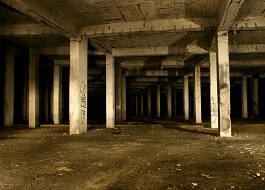
Prague intends to support the underground of the Stalin monument
 |
"The assessments (of the report) indicate that the structures are bending, and in some cases by up to two or three times beyond what the standards allow. This is due to non-functional insulation. The lifespan of that structure is around 50 years, and it is now already 70 years old," said Chabr.
According to Chabr, the quickest and most effective solution would now be to secure the underground space with supports that would prevent potential collapses. Supporting it would require investments in the range of lower millions of crowns. The system would have the advantage of not only lower costs compared to a complete renovation but would also mean that the area around the former statue would not have to be closed off and could remain passable. "The supports would secure the sagging areas and guarantee that there would be no collapse," Chabr said.
A complete renovation of the underground would, according to the councilor, cost hundreds of millions of crowns. Before the city undertakes such work, he believes it would be wise for the city to decide how it will utilize the space in the future. "In the past, minimal repairs were carried out there, but none of the previous political representations made a decision about it. Even minimal repairs will mean renovations in the range of hundreds of millions. The question remains what we want to do with it next, whether only static securing of the Letná parks," said Chabr.
The leadership of Prague has commissioned two expert assessments. Once they are familiar with them, they will start discussions with Prague 7 and its building department on how to proceed.
The previous leadership of Prague planned to build a gallery underground. The current leadership rejected this idea. Representatives of the United Forces for Prague (TOP 09) proposed after the elections to create a museum of totalitarian regimes there. This proposal was also not approved by the city, especially not favored by representatives of Prague Sobě.
One of the most bizarre European communist monuments was unveiled in 1955 after six years of construction when the era of honoring the Soviet leader, who died in 1953, was nearing its end. In February 1956, Stalin's successor Nikita Khrushchev condemned the cult of Stalin's personality at the 20th Congress of the Communist Party of the Soviet Union. Despite this, Prague communists decided to remove the 22-meter-high monument only in the early 1960s.
In the early 1990s, cultural events were held in the spaces inside the pedestal. The largest was the exhibition Totalitarian Zone, during which Radio 1 began to broadcast pirated signals from within the monument, initially as Radio Stalin.
The English translation is powered by AI tool. Switch to Czech to view the original text source.
0 comments
add comment
Related articles
0
26.09.2019 | Prague will apparently partially reopen the area around the Stalin monument
0
17.09.2019 | Opinion: The roof of the underground Stalin monument may collapse
0
05.12.2018 | The gallery in the base of the former Stalin monument in Prague will not be
0
07.09.2018 | Fajt: The appearance of the space under Stalin will be determined by an architectural competition
0
08.08.2018 | Possible modifications of the former Stalin monument at Letná face criticism
0
13.07.2016 | Svah pod Letnou could be transformed into an exhibition hall
0
24.04.2006 | Photographs at Letná remind of the author of the Stalin monument










